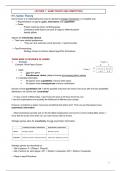Summary
Managerial Economics (D0h52a) Summary of the new pro 2024
- Course
- Institution
- Book
Summary of the course Managerial Economics: Analytical Tools (D0h52a), taught in the 2nd year of Business Engineering (in Policy Informatics) by Tommaso Alba. Slides and lessons summarized, at least clearer than the pros are slides! This summary can be used instead of the slides.:)
[Show more]




